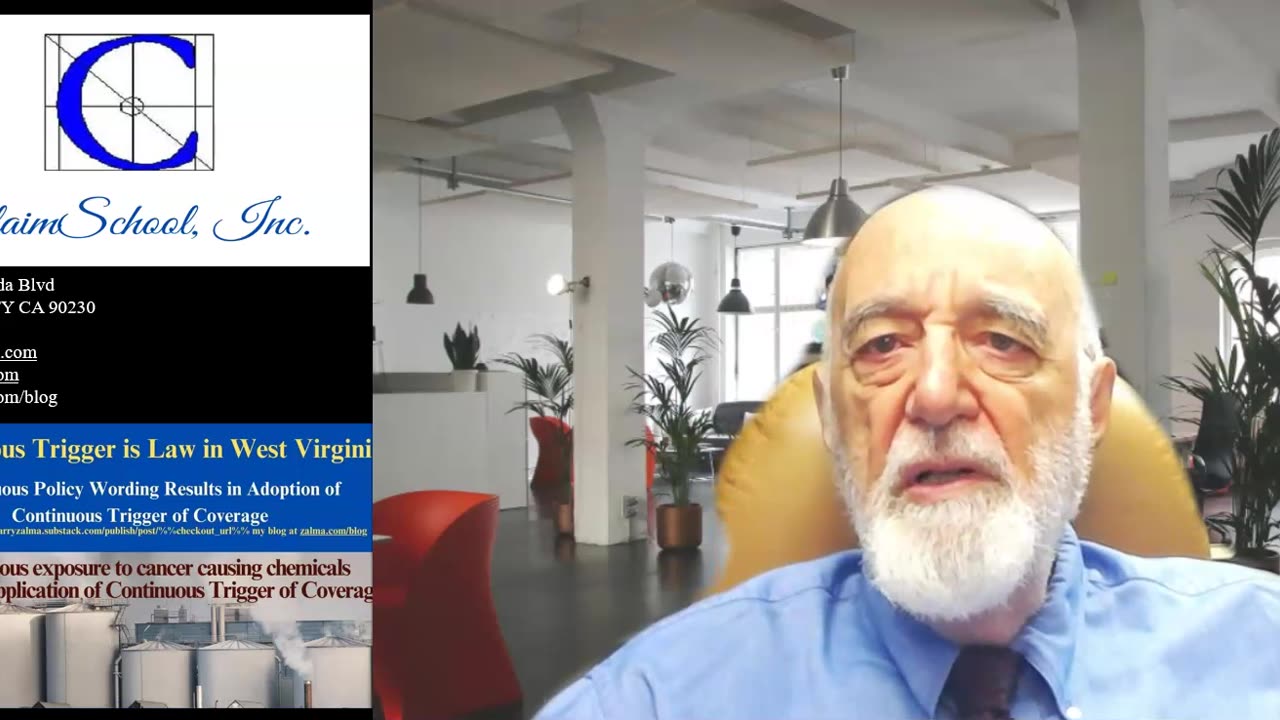Premium Only Content

Contiguous Trigger is Law in West Virginia
Ambiguous Policy Wording Results in Adoption of Continuous Trigger of Coverage
The United States Court of Appeals for the Fourth Circuit certified a question to the Supreme Court of Appeals of West Virginia asking: "[a]t what point in time does bodily injury occur to trigger insurance coverage for claims stemming from chemical exposure or other analogous harm that contributed to the development of a latent illness?"
In Westfield Insurance Company v. Sistersville Tank Works, Inc.; et al, No. 22-848, Supreme Court of Appeals of West Virginia (November 8, 2023) the Court answered the question. The Supreme Court answered the question with the conclusion that a "continuous-trigger" theory applies to the policy, as the policy is ambiguous as to when coverage is triggered.
OPINION
The gateway to coverage under every standardized, commercial general liability (or "CGL") policy issued in the United States since 1966 is proof that a bodily injury or property damage has "occurred."
FACTUAL BACKGROUND
Sistersville Tank Works ("STW") has, since late 1984, been a family-owned and -operated West Virginia corporation. STW manufactures, installs, and repairs various types of tanks at industrial sites throughout world, including at several chemical plants in West Virginia.
Beginning on the first day of 1985, STW was protected under a commercial general liability ("CGL") policy it purchased from Westfield Insurance Company ("Westfield"), an Ohio corporation. Westfield thereafter renewed STW's coverage under a series of CGL policies with one-year (or more) coverage periods. The CGL policy defines a "bodily injury" as a "bodily injury, sickness or disease sustained by a person, including death resulting from any of these at any time."
At different points in 2014, 2015, and 2016, three men were diagnosed with various forms of cancer. In 2016 and 2017, the "claimants" (the men with cancer and/or their spouses) sued STW in three separate lawsuits in West Virginia state courts. The claimants alleged the cancers were, in some part, caused by STW's tanks.
STW asked Westfield to provide a defense and indemnification to the three lawsuits under its previously purchased CGL policies. Westfield denied coverage under its CGL policies for the three suits and, in June 2018, filed a complaint against STW for declaratory relief and after discovery, the parties filed competing motions for summary judgment.
In an order dated September 4, 2020, the district court granted a judgment in favor of STW and found Westfield owed STW a duty to defend and to indemnify under all of its policies issued from 1985 through 2010. The district court concluded that Westfield's promise to cover a bodily injury that "occurs during the policy period" was ambiguous in light of the latent disease claims asserted against STW. The district court ruled that the language in Westfield's policy did not clearly identify when coverage was "triggered" in instances where a claimant alleged repeated chemical exposures and the gradual development of a disease over successive policy periods.
The Supreme Court had never addressed the question raised before the district court. Nevertheless, the district court calculated that this Court would apply the continuous-trigger theory to clarify the ambiguous language in Westfield's policy.
DISCUSSION
Occurrence-based CGL policies provide coverage if the event insured against takes place during the policy period, irrespective of when a claim is presented. The certified question raises a different, more complicated set of circumstances. Westfield contends that manifestation of a disease is the sole trigger of coverage under its occurrence-based CGL policies.
On the other hand, STW takes the position that the occurrence language incorporates a "continuous" trigger theory of coverage. STW's argument encompasses the entirety of Westfield's insuring agreement. STW points out that, by definition, an "occurrence" under Westfield's policy includes "continuous or repeated exposure" to a "harmful condition []" that results in "bodily injury, sickness or disease."
It is evident from the parties' competing positions that the meaning of the policy's insuring agreement is uncertain or doubtful in the context of latent or progressive diseases, as the parties have shown the occurrence language used is susceptible to at least two plausible constructions. Here, the occurrence and bodily injury provisions that Westfield chose to incorporate into its insuring agreement fail to precisely articulate a trigger of coverage. They are, the Supreme Court concluded, ambiguous.
History shows that the "occurrence" language incorporated into the CGL policy was designed with the goal of affording coverage for singular, repeated, or continuous exposures to hazardous substances if those exposures cause either a singular or a progressive bodily injury, sickness, or disease. The Supreme Court concluded, after review of the history of the drafting of the CGL, that the drafters of the occurrence language used by Westfield intended to incorporate a continuous trigger of coverage.
The Policy Language Supports A Continuous Trigger
The reasoning of the Supreme Court’s recognition of the continuous trigger of coverage has the effect of spreading the risk of loss widely to all of the occurrence-based insurance policies in effect during the entire process of injury or damage. As one court said, the continuous trigger theory is the most efficient doctrine for allocation of liability amongst insurers for toxic waste cases, because it encourages all insurers to monitor risks and charge appropriate premiums.
Therefore, an occurrence based CGL policy covers all injuries, sicknesses, or diseases that occur during coverage, not merely those that become manifest.
Under the continuous-trigger theory, when a claim is made alleging a progressive injury caused by chemical exposure or other analogous harm, every occurrence-based policy in effect from the initial exposure, through the latency and development period, and up to the manifestation of the bodily injury, sickness, or disease, is triggered and must cover the claim.
ZALMA OPINION
It is axiomatic that when a court finds an ambiguity in an insurance policy it must be interpreted in favor of coverage for the insured. West Virginia found the policy was ambiguous as to trigger and therefore, overruling a strenuous dissent, and applied the continuous trigger expanding the coverages available to STW for the claims of the plaintiffs that STW was responsible for the illnesses because under the continuous-trigger theory of coverage every moment from the first exposure to the harmful chemicals up to and including the date of diagnosis would be covered by Westfield's policy.
(c) 2023 Barry Zalma & ClaimSchool, Inc.
Please tell your friends and colleagues about this blog and the videos and let them subscribe to the blog and the videos.
Subscribe to Excellence in Claims Handling at locals.com at https://zalmaoninsurance.locals.com/subscribe or at substack at https://barryzalma.substack.com/publish/post/107007808
Go to Newsbreak.com https://www.newsbreak.com/@c/1653419?s=01
Follow me on LinkedIn: www.linkedin.com/comm/mynetwork/discovery-see-all?usecase=PEOPLE_FOLLOWS&followMember=barry-zalma-esq-cfe-a6b5257
Daily articles are published at https://zalma.substack.com. Go to the podcast Zalma On Insurance at https://podcasters.spotify.com/pod/show/barry-zalma/support; Go to Barry Zalma videos at Rumble.com at https://rumble.com/c/c-262921; Go to Barry Zalma on YouTube- https://www.youtube.com/channel/UCysiZklEtxZsSF9DfC0Expg; Go to the Insurance Claims Library – http://zalma.com/blog/insurance-claims-library.
-
 7:40
7:40
Barry Zalma, Inc. on Insurance Law
1 year agoLoss of Inventory by Bankruptcy
196 -
 LIVE
LIVE
Grant Cardone
2 hours agoHow to Buy Real Estate With NO Money Down (LIVE Training With Grant Cardone)
6,953 watching -
 19:53
19:53
MetatronHistory
16 hours agoRome VS Greece - Ultimate Clash of Civilizations Explained
17K6 -
 LIVE
LIVE
VapinGamers
1 hour agoTools of the Trade - EP12 The Art of Story Telling with MidnightinTheMountains - !rumbot !music
365 watching -
 LIVE
LIVE
SOLTEKGG
44 minutes ago🔴LIVE - Battlefield 6 - Going Pro in RED SEC
100 watching -
 LIVE
LIVE
Midnight In The Mountains™
2 hours agoThe Midnights Play Arc Raiders | Loot Scoot and KILL | Crypto Wallet up n running GO JOIN THE BETA!
139 watching -
 53:25
53:25
X22 Report
3 hours agoMr & Mrs X - Trump Is Using The Same Tactic As Our Founding Fathers To Rebuild America - EP 17
54.9K11 -
 LIVE
LIVE
PudgeTV
37 minutes ago🟣 Arc Raiders - Gaming on Rumble | Going Topside w My Daughter’s Husband
79 watching -
 2:05:43
2:05:43
LFA TV
20 hours agoRUMBLE RUNDOWN WEEK 7 with SHAWN FARASH 11.22.25 9AM
115K7 -
 LIVE
LIVE
ttvglamourx
1 hour agoGLAMOURX VS CALL OF DUTY LOBBIES !DISCORD
160 watching